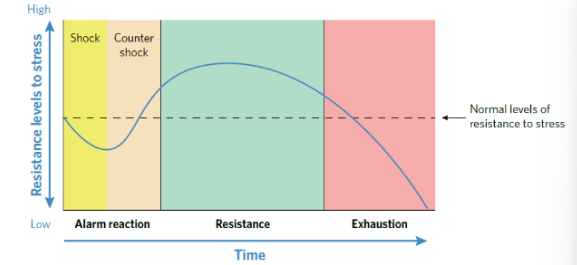3B - Selye's General Adaptation syndrome (GAS)
1/8
There's no tags or description
Looks like no tags are added yet.
Name | Mastery | Learn | Test | Matching | Spaced |
|---|
No study sessions yet.
9 Terms
Generalm Adaptation Syndrome (GAS)
A three-stage physiological response to stress that occurs regardless of the stressor that is encountered.
Alarm reaction (Shock & Countershock)
Resistance
Exhaustion
GAS graph

Alarm Reaction
Occurs when the person or animal first becomes aware of the stressor.
Defensive reaction creating tension and alertness as well as readiness to respond to the stressor.
Shock (alarm)
Ability to deal with the stressor falls below normal level
Body reacts as if injured: BP and Temperature drop below normal, loss of muscle tone
PARASYMPATHETIC NS ACTIVATION
cortisol is not released yet, as body is not ready to deal with the stressor
Countershock (Alarm)
Sympathetic NS - FFF response occurs
adrenaline, noredrenaline and cortisol are released
Body's resistance to the stressor increases
Organism becomes highly aroused and alert in preparation to deal with the stressor.
Increase in heart rate, breathing rate and blood glucose levels
Resistance
Body's resistance to the stressor rises above normal
Intense arousal of stage 1 decreases, but physiological arousal remains above normal.
Unnecessary physiological processes are shut down to save energy (digestion, growth, sex drive, menstration)
Cortisol continues to be released into the bloodstream
If present for a long time, immune system becomes supressed (Increases susceptability to developing illness)
Ability to deal with the initial stressor increases, But resistance to other stressors may decline.
Exhaustion
The body cannot maintain resistance and cannot deal with the stressor.
Body's resources are depleted (lowered cortisol) as it has been dealing with the stressor for a prolonged time.
Resistance to disease is weak (from high cortisol levels in bloodstream), more vulnerable to physical and mental illness, Wear and tear.
Symptoms: extreme fatigue, high levels of anxiety, symptoms of depression, nightmares, impaired sexual performance, hypertension, gastrointestinal problems and heart disease.
Strengths of the GAS model
Recognises a predictable pattern of physiological responses associated with distinct stages and substages, which can be measured in individuals.
Recognises the relationship between chronic stress and illness.
Provides objective, empirical information about the biological processes (e.g. hormone secretion) involved in the stress response.
Limitations of the GAS model
A ‘one size fits all’ model; fails to recognise the subjective nature of the stress response and therefore doesn’t take into account how different people respond to stressors.
Only focuses on the biological aspects of stress. It ignores the importance of psychological factors, including emotion and cognition (interpretation), in the stress response.
Based on research that was conducted on rats, reducing the generalisability of the model to the human population.